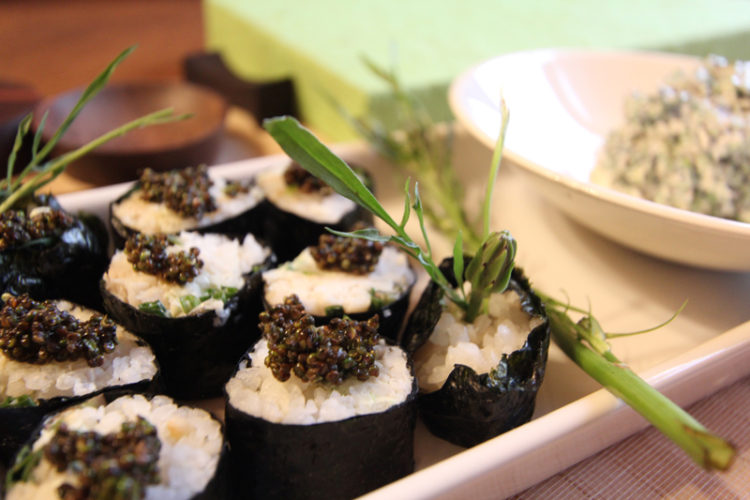
I almost didn’t believe my first bite of wild-made tonburi—a preparation that involves boiling and soaking kochia seeds to make what is referred to as “land caviar.” The green and black seeds swell to a gelatinous texture with a shiny finish, and the mouth feel is the simultaneously slippery and crunchy texture of caviar.
The flavor is quite nice too. Tonburi has been described as tasting of broccoli and artichoke, and can be seasoned to give it a caviar-like flavor. According to tonburi purveyor BienManger, it is a specialty of the Akita prefecture in Japan and an ingredient in Buddhist vegetarian Shojin-ryori cuisine. It is often served seasoned with smoked fish or blended into a mayonnaise.
Truly, this is a wonderful ingredient—and with a little know-how and effort, we can access it for free. That’s because kochia (Kochia scoparia syn. Bassia scoparia), a non-native and some say noxious weed, is very plentiful in regions west, and in localized areas around the world.
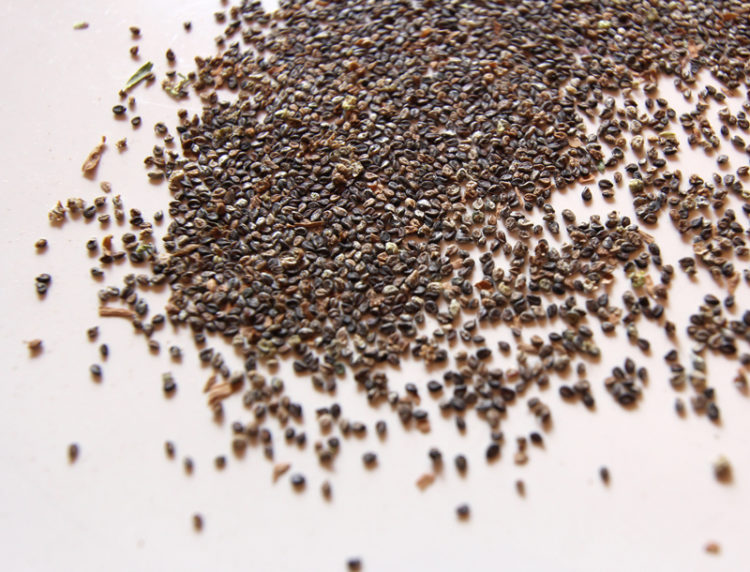
Getting the Seeds
Kochia seeds can be collected from late summer well into fall. The plant is easy to spot at this time because it often turns bright red before drying out to brown. In cultivated varieties, the entire foliage can appear red, such as in the magnificent display of cultivated kochia spheres at Hitachi Seaside Park in Japan.
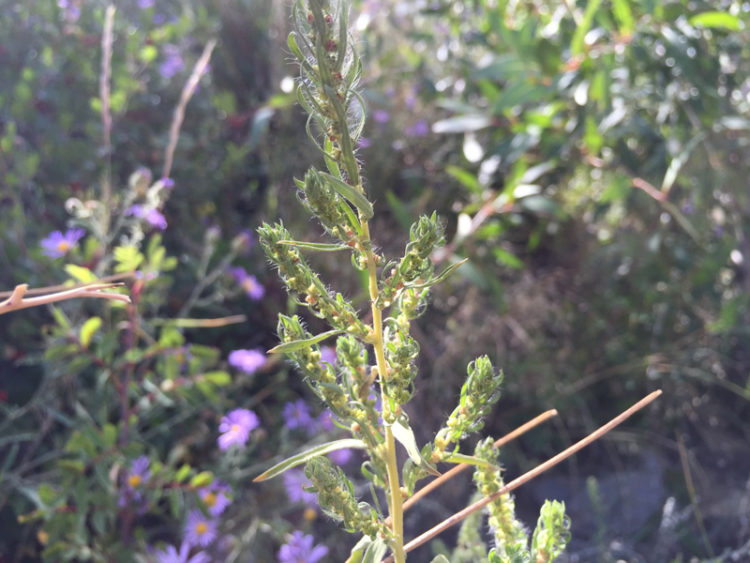
Kochia proliferates in Denver, where it can grow taller than my head, and in my backyard at 10,000 feet in Colorado’s South Park. It is a common weed, often found in nearly pure stands spanning miles and miles of agricultural field borders and roadsides.
In maturity, kochia has the appearance of a rounded-out, many-branched tumbleweed. Unlike Russian thistle (Salsola kali), another tumbleweed often found growing nearby, kochia is not spiny or otherwise injurious. The dry seed spikes sport tiny, inconspicuous fruits that, upon inspection with a magnifying glass, look a bit like flowers or stars because they have five, somewhat pointed, papery wings surrounding them. Each of the many tiny stars clustered on each branch has a skinny leaf sticking out from its base, and each contains a flat, teardrop-shaped black seed.
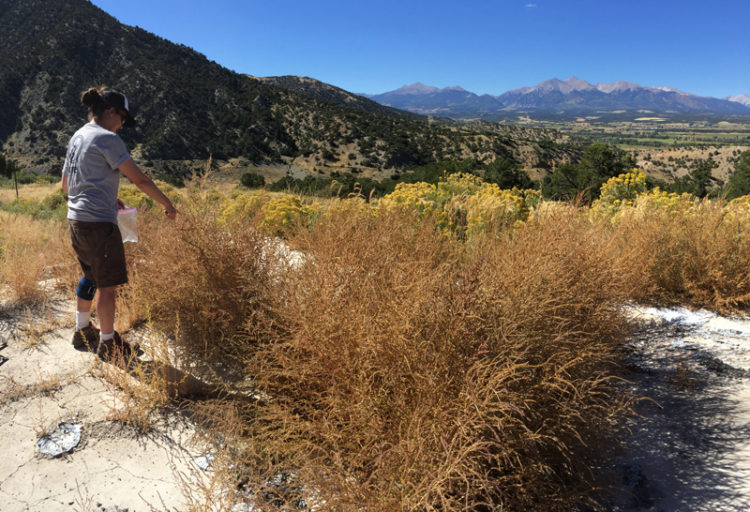
Kochia seeds and chaff can be stripped into a collecting container easily by running a gripped hand along the branches. The tips of the branches left behind are filament-like—soft, white, and fuzzy at the tips. Since kochia tends to cover large areas and is a prolific seed producer, a patient forager can gather a substantial amount of fruits and tiny seeds.
Making Tonburi
My method for making tonburi from the dried, wild-foraged seeds involves first dumping the material into a big bowl and rubbing it between my fingers for a while. This is easy to do while watching TV. The process loosens the chaff and seed coats from the seeds.
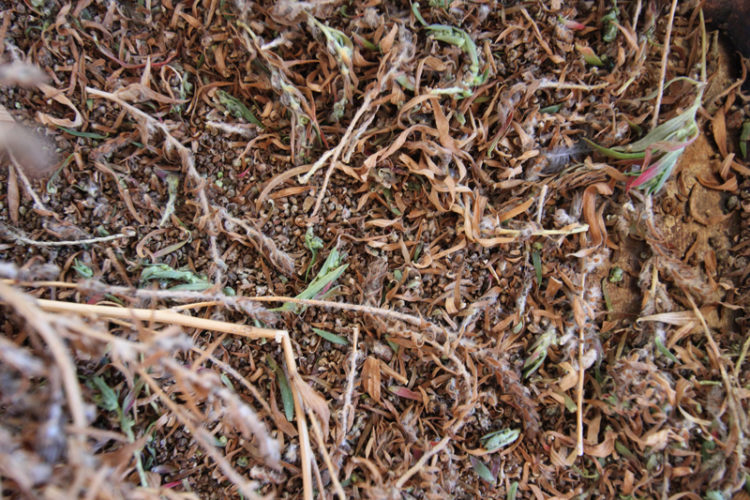
Next, because kochia is an easily spread non-native species, I don’t use my normal blow-in-the-bowl method to separate the excess leaf material and dry fruit casings. Instead I sift out the smallest bits of chaff through a sieve (I use our spatter guard), then employ my better half’s tap-the-cookie-sheet method to separate the rest. (This involves spreading the material out at one end of the cookie sheet, tilting it slightly, and tapping from underneath or above so the seeds roll and bounce to the other end, leaving the chaff behind.) It’s an imperfect method because the chaff inadvertently slides down too, so every tenth tap or so you have slide all the material back to the upper end of the tray. But the seeds do collect at the base, and can be transferred to a bowl by the spoonful as each batch is completed. Some chaff is likely to remain in the mix, but does not detract too much from the final product.
After winnowing, the next step is to boil the seeds until soft, which for me took about 10 minutes at 10,000 feet, and then plunge them right away into cold water and let them soak overnight. Next, it is good to give the wet seeds another thorough rubbing to loosen any remaining seed coats, which can then be decanted off with the water. Then, rinse and strain to produce the caviar-like, vegan tonburi.
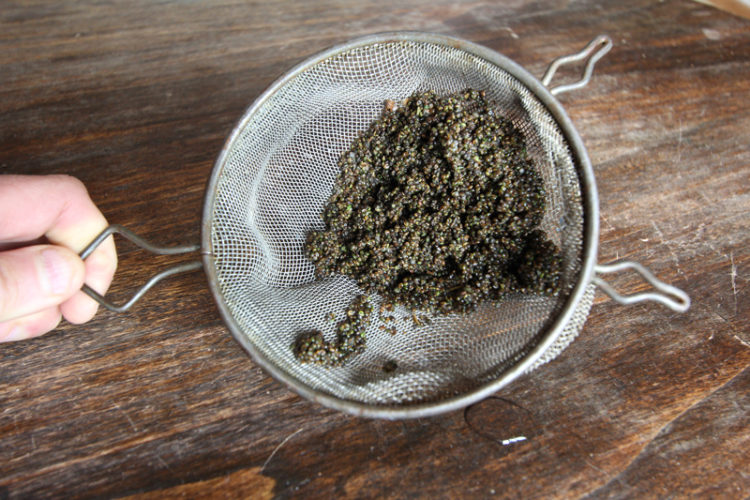
Invasive Species-Made, Vegan Caviar
I used to buy caviar when I lived in California. Since then it seems to have increased in price, or I have just become poorer. In any case, I never purchase it anymore.
Black caviar from wild-caught sturgeon is a no-no on the Seafood Watch list from Monterey Bay Aquarium. “All 26 wild sturgeon species around the world are depleted or near extinction,” they explain. “These fish grow slowly, mature late and can’t keep up with the high demand for caviar.” The group recommends opting for caviar farmed in the U.S. or Canada as a best choice.
The first time I made it, I stared at my invasive-species-made, vegan caviar in disbelief for a while. What would you make if a sudden bounty of almost-caviar landed in your lap?
Online searches produced some exciting ideas. I found an image of butter-poached Murray cod with baby radish, braised Japanese daikon, tonburi, and crystallized wakame; another of chilled oyster soba, champagne jelly, pickled cucumber, and tonburi. I drooled over lobster with fried ribbons of sweet potato, tonburi, and lobster sauce. And the list goes on.
Although many sites describe tonburi as a gourmet delicacy, one commenter noted that according to Japanese-language websites, the seeds “only became ‘food’ after people in modern Akita prefecture were on the verge of starvation.” Whether delicacy, starvation food, or sustainable substitute for a depleted resource, I don’t care. The swollen kochia seeds are simply fantastic.
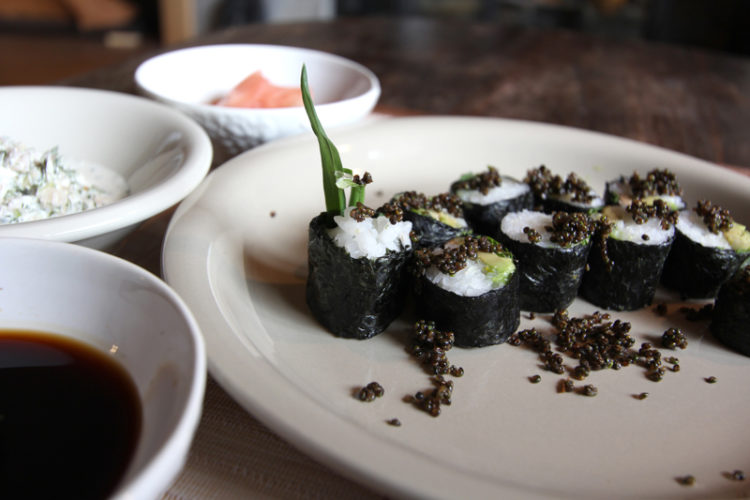
In the end I made a million sushi rolls, using a palette of ingredients both wild and cultivated, topping each with a gorgeous trickle of tonburi.
You Can Have This Much Fun Too
For me, collecting wild seeds is a meditative activity, as is the time spent winnowing and rubbing. The entire process feels quietly transformational—and all the more so with kochia seeds, which turn into such magical “land caviar.”
When the kochia turns red in fall and then dries to brown, I exhort you, go ahead and collect some seeds. Let them dry out fully; it takes but a minute to spread them on a tray. You don’t even have to use them right away. But I promise—if you are willing to one day take the idea to fruition, there is a pot of gold at the end of this kochia rainbow.
UPDATE 10.22.17: Some people have reported an uncomfortable sensation in the throat upon consumption. I suspect saponins in the seed coats could be responsible, but have not verified this. However, I added an extra rub-and-rinse after soaking to the procedure described above as a precaution. That said, as with any wild edible, try just a little your first time. I find that combining it with other ingredients reduces the effect.

I wish I were more certain of my kochia identification skills. It’s a new plant for me. I’m going to take that photo of the mature plants with me when I go out next time.
Hi Ellen, By all means let me know if there’s anything I can clear up for you, or describe better. Any specific questions on the description. Sincerely -erica
Wow, I always learn something new from you (even if I’m not usually in a commenting mood.) I grew up surrounded by fields of these, and never knew! Just curious though, kochia & chia, both seeds that swell up gelatinously. Are they related at all?
I don’t think they’re too closely related. Chia is in the mint family, whereas kochia is among our wild spinach relatives. I think chia swells more and gets more gelatinous. The kochia swells but I don’t think of it as all that gelatinous. Hope that helps:)
Hi, I just found this article on tonburi made from kochia and I am very intrigued. I live in southern Colorado and kochia is extremely prolific down here. My question is this, how would you season the seeds to taste like caviar? Lots of salt? Thanks! I’ll let you know how it goes. – Joni
Hi Joni, yes, salt, maybe a pinch of sugar. I’ve also played with rice vinegar as a seasoning. If I settle on a precise recipe I’ll let you know. In the meantime, please do let me know how it goes! Cheers:)
@erica – I had “vegan caviar” at Single Thread recently and was so taken by it – found your recipe. Did you ever come up with a “precise recipe” for the seasoning? Cheers! Sandy
Oh! Did they use the same seeds (kochia) for it?
Hi,
Do you know where I can buy kochia seeds to make tonburi? I’d love a source for edible seeds! Thank you
Gosh, not off hand. Maybe Google “burning bush seeds” and see if the results are kochia.
Hi , do you know if there is a market for this seed as I have 25,000 bushels of it on hand. Combine it every year to try to keep if off the wheat fields as much as possible.
Hi Donna, I don’t know of a market for it yet at this point but I am quite intrigued. I would take a bushel off your hands but I’m not sure that helps you much!
Thank you for the gift of this knowledge! I have a property full of these plants and have always seen them as simply a menace because of them becoming fire hazard tumbleweeds every winter/spring.
I can’t wait to try out this process and help to transform our relationship to these plants.
I would love to hear how it goes!